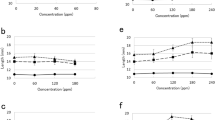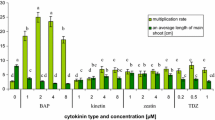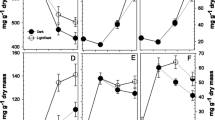Abstract
Coleoptile and root tips ofTriticum aestivum cv. Arnej 624 and those ofAvena sativa cv. Victory (Svalöf) as well as dry excised embryos ofTriticum aestivum cv. Rival (Svalöf) and those ofArachis hypogaea cv. 34 3A. H. were cultivated in media containing various concentrations of sucrose and growth regulators, like ascorbic acid, indole-3-acetic acid and gibberellin. Growth, differentiation and water uptake of the various explants were determined at regular time intervals. Further, the concentration of the endogenous ascorbic acid in mg./g. fresh weight, as well as the amount of this growth regulator utilized as per cent of the total were determined.
Although all the three growth regulators promote growth in the explants, their effect is best felt when sucrose of a higher concentration (1.0 per cent) is added to the medium. In fact, the response to 1.0 per cent sucrose is sometimes as good as a combination of a growth regulator with sucrose, especially in the case of root explants.
The results clearly indicate that the biosynthesis of ascorbic acid in the explants is catalyzed by the addition of indole-3-acetic acid as well as gibberellin. Simultaneously, the utilization of ascorbic acid is also appreciably increased by the presence of these growth regulators.
Addition of 1.0 per cent sucrose to the medium containing the above mentioned growth regulators augments to a considerable extent not only the concentration of ascorbic acid, but also steps up its utilization. Enhancement of ascorbic acid as well as its increased utilization are correlated with rapid imbibition of water, growth and differentiation.
The role of ascorbic acid in growth is discussed; and on the basis of the data presented here it is postulated that: (1) auxin and gibberellin function in the growth process by catalyzing the biosynthesis of ascorbic acid; and (2) that ascorbic acid not only participates in activation of various enzyme systems, but also stimulates the production of adenosine triphosphate by acting as an electron donor in photosynthetic phosphorylation as well as oxidative phosphorylation; (3) that the above action of ascorbic acid creates a favourable redox balance for synthesis of nucleic acids, proteins, enzymeproteins, and cell-wall constituents, thus enabling the processes of cell division and enlargement to proceed at a fast rate; and (4) that the relative rates of cell division and cell enlargement as well as “ageing” will determine the pattern of plant development.
Abstract
Koleoptile a kořenové špičky Triticum aestivum cv. Arnej 624 a Avena sativa cv. Victory (Svalöf) a embrya Triticum aestivum cv. Rival (Svalöf) a Arachis hypogaea cv. A. H. 334 byly pěstovány na médiu s různými koncentracemi sacbarosy a růstových regulátorů jako kyselina askorbová, kyselina indolyl-3-oetová a giberelin. V pravidelných intervalech byl stanovován růst, differenciace a příjem vody různých explantátů. Byla zjištována také koncentrace endogenní kyseliny askorbové v mg/g čerstvé váhy a spotřebované množství tohoto regulátoru v % celkového množstvi.
Všechny tři růstové regulátory stimulují růst explantátů, přičemž jejich účinek je silnější při větším obsahu sacharosy v médiu (1 % ). Sacharosa v koncentraei 1 % je v některých případech stejně ůcinná jako kombinace růstového regulátoru se sacharosou zejména u kořenových explantátů.
Výsledky jasně ukazuji, že biosynthesa kyseliny askorbové v explantátech je katalysována; přidáním indol-3-oetové kyseliny a giberelinu. Spotřeba askorbové kyseliny je také znač ně zvýšena za přítomnosti těchto růstových regulátorů.
Přidání 1 % sacharosy do média obsahujícího uvedené růstové regulátory nejen značně zvy šuje koncentraci kyseliny askorbové, ale také velmi silně zvašuje její utilisaci. Oba procesy korelují s rychlým přibýváním obsahu vody, růstem a diferenciací.
Je diskutována úloha kyseliny askorbové při růstu. Na základë údajů uvedených v dané práci se předpokládá, že: (1) auxin a giberelin se ůčastní v růstových pochodech katalysováním biosynthesy kyseliny askorbové, (2) kyseliny askorbová nejen že se účastní aktivace četných enzymový ch systémů, nýbrž také stimuluje produkci adenosintrifosfátu tím, že je donorem elektronu ve fotosynthetické fosforylaci a při oxidativní fosforylaci; (3)uvedené působení kyseliny askorbové vytváří vhodnou redox rovnováhu pro synthesu nukleových kyselin, proteinů, enzymových proteinů a složžek buněčné stěny a tím umožňuje rychlejší průběh buněcného dělení a dlouživého růstu; (4) poměrné rychlosti dělení a prodlužování buněk stejně jako stá rnutí určují průběh vývoje rostlin.
Abstract
Колеоптиле и верхушк и корней Triticum aestivum cv. Arnej 624 и. Avena sativa cv. Victory (Savalöf) и зародыши Triticum aestivum cv.Rival (Svalöf) и Arachis hypogaea cv. A. H. 334 выращивались на ср едах с разными концен трацинми сахарозы и р остовых регуляторов, как аско рбиновая кислота, инд ол-3-уксусная кислота и гиоберелин. Б правилъных промежу тках времени определ нли рост, дифференциа цию и поглощение воды у разных зксплан татов. Определяли так же концентрацию эндо генной аскорби новой кислоты в мг/г св ежего веса и исполъзо ванное количество эт ого регулнтора в % отобщего количеств а. Все три регулятора ро ста стимулировали ро ст эксплантатова и их эффект был боль шим нри более высокой концентрации сахаро зы в среде(1%). Сахароза в концентрации 1% имела в некоторых слу чанх такой же зффскт, к ак и комбинация регул ятора роста
с сахарозой, в особенн ости у эксплантатов к орней. Результаты выразите лъно ноказывают, что б иосинтез аскорбинов ой кислоты в экс плантатах катализир уется нри прибавлени и индол-3-уксусной кисл оты и гибберелина. Потребление аскорби новой кислоты также з начнтельно повьпнен о в присутствии зтих
ростовых регулнторо в. Прибавка 1% сахарозы в с реду, содержащую нрив сденные ростовые рег уляторы, не только значительно п овышает концентрацн ю аскорбиновой кисло ты, но также очень сильно повышает ее ут илизацпю. Оба процссс а коррелируют с быстр ым позлощением
воды, ростом н диффере нциацией. Обсуждаетсн роль аск орбиновой кислотъ. в р остовых нроцессах. На основании цанных настоящей раб оты ностулируется: (1) а уксин и гибберелин уч аствуют в росте катализируя биосинт ез аскорбиново йкисл оты, (2) аскорбиновая ки слота не толъко
участвует в активацп и многих энзиматичес ких снстем, но также ст имулирует про дукцию аденозинтриф осфата тем, что она явл яется донором электр онов при фото синтетическом н окис лительном фосфорнли ровании, (3) приведенные действин аскоо биновой кислоты созд ают нодходящее редок с равновесне для синт еза нуклеиновых кислот, протеинов, знз иматических нротеин ов н комнонентов клет очной стенки и тем самым снособствует б олее скорому прохожд снию процессов делеnн я и удлинения клеток; (4) относителъны е скорости деленин и у длиненин клеток вмес те со «старением» определнют ход разви тия растений.
Similar content being viewed by others
References
Åberg, B.: Effects of light and temperature on the ascorbic acid content of green plants.- (cited from Asselbergs, 1957).
Arnon, D. I.: Photosynthesis by isolated chloroplasts. IV. General concept and comparison of three photochemical reactions. -Biochim. biophys. Acta20: 449–461, 1956.
Arnon, D. I.: Triphospho-pyridine nucleotide as a catalyst of photosynthetic phosphorylation. - Nature180: 182–185, 1957.
Arnon, D. I.: Assimilatory power in photosynthesis. - Science127: 1026–1034, 1958.
Asselbergs, E. A. M.: Studies in the formation of ascorbic acid in detached apple leaves. - Plant Physiol.32: 326–329, 1957,
Brown, R., Reith, W. S., Robinson, E.: Mechanism of plant cell growth in structural aspects of cell physiology. - Symp. Soc. Exptl. Biol., No. 6: 328–347. Academic Press, Inc., New York, 1952.
Chinoy, J. J.: Formation and utilization of ascorbic acid in the shoot apex of wheat as factors of growth and development. -Indian J. Plant Physiol.1 and 2: 172–201, 1962.
Chinoy, J. J.: Ascorbic acid - nucleic acid - protein metabolism concept of flowering in plants. - Proc. X Internati. Bot. Congr., Edingburgh. (Abstr.) pp. 347–349, 1964.
Chinoy, J. J., Grover, R., Nanda, K. K. : Sucrose as precursor of regulatory substances inAvena coleoptile. - Proc. Seminar on Modern Developments in Plant Physiology, Univ. of Delhi, 26–30, 1958.
Chinoy, J. J., Grover, R., Nanda, K. K.: Role of sucrose in the growth reaction ofAvena coleoptile sections. - Flora150: 1–10, 1961.
Chinoy, J. J., Grover, R., Sirohi, G. S.: A study of the interaction of ascorbic acid in the growth ofAvena coleoptile sections. - Physiol. Plant.10: 92–99, 1957.
Chinoy, J. J., Nanda, K. K.: Auxin catalized biosynthesis of ascorbic acid by dry excised embryo of wheat, - Proc. IX Internl. Bot. Congr., Abstracts 2, 69, 1959.
Galston, A. W., Purves, W. K.: The mechanism of action of auxin. - Ann. Rev. Plant Physiol.11: 239–276, 1960.
Garg, O. P., Chinoy, J. J., Nanda, K. K.: Interaction of ascorbic acid and colchicine on growth and development ofBrassica chinensis L. -Proc. Seminar Modern Developments in Plant Physiology, Univ, of Delhi, pp. 20, 1958.
Giroud, A.: L’acide ascorbique dans les cellules et les tissues. - Protoplasma Mongr. 16. Asselbergs, 1957. Berlin, Gebr. Borntrager, 187 p., 1938.
Grover, R., Chinoy, J. J. T., Nanda, K. K.: Growth regulating action of ascorbic acid inAvena coleoptile sections. - Sym. The recent advances in the study of plant metabolism. - Univ. of Allahabad 41, 1958.
Haagen, U.: The daily changes of vitamin C-content in foliage leaves. - Biol. Abstr.29: 945, Abstr. 2754, 1955, 1953.
Mapson, L. W.: Metabolism of ascorbic acid in plants. Part I. Function. - Ann. Rev. Plant Physiol.9: 119–150, 1958.
Marre, E., Arrigoni, O.: Metabolism reactions to auxin I. The effects of auxin on glutathione and the effects of glutathione on growth of isolated plant parts. - Physiol. Plant.10: 289, 1957.
Mitsui, A., Oi, Y.: Endogenous changes of photochemical activities of spinach leaves. - Plant and Cell Physiol.2: 45–50, 1961.
Popovskaya, E. M.: To the formation and translocation of ascorbic acid in plants. - Biokhymia15: 249–55, 1950.
Peokoshew, S. M., Dantsheva, E. I.: Factors of ascorbic acid biosynthesis. - Biokhymia11: 481–491, 1946.
Reid, M. E.: Localization of ascorbic acid in the cowpea plant at different periods of development, - Amer. J. Bot.24: 445–447, 1937.
Reid, M. E.: The effect of light on the accumulation of ascorbic acid in young cowpea plants. - Amer. J. Bot.25: 701–711, 1938.
Reid, M. E.: Relation of vitamin C to cell size in the growing region of the primary root of cowpea seedlings. - Amer. J. Bot.28: 410–415, 1941.
Reid, M. E.: Metabolism cf ascorbic acid in cowpea plants. - Bull. Torrey Bot. Club68: 359–371, 1941.
Reid, M. E.: A study of physical and chemical changes in the growing region of primary roots of cowpea seedlings. - Amer. J. Bot.28: 45–51, 1941.
Reid, M. E.: Relation of temperature to the ascorbic acid content of cowpea plants. - Bull. Torrey Bot. Club68: 519–530, 1941.
Reid, M. E.: Effects of variations in light intensity, length of photoperiod and availability of nitrogen upon accumulation of ascorbic acid in cowpea plants. - Bull. Torrey Bot. Club69: 204, 1942.
Reid, M. E.: Interrelations of calcium and ascorbic acid to cell surfaces and intercellular substances and to physiological action. - Physiol. Rev.23: 76–99, 1943.
Schneider, C. L.: The interdependence of auxin and sugar for growth. - Amer. J. Bot.25: 258. 1938.
Smith, F. G.: Ascorbic acid formation in potato tuber slices. - Plant Physiol.27: 736, 1952.
Tonzig, S. andMarre, E.: Ascorbic acid as a growth hormones in plant growth regulation. - Proc. IV. Internl. Conf. Plant Growth Regulation, pp. 725–734. The Iowa State University Press, Ames., Iowa, XJ. S. A., 1961.
Author information
Authors and Affiliations
Rights and permissions
About this article
Cite this article
Chinoy, J.J., Shah, C.K., Patel, H.T. et al. Role of auxin and gibberellin in the synthesis of Ascorbic Acid and growth of tissue explants. Biol Plant 9, 182–194 (1967). https://doi.org/10.1007/BF02929736
Received:
Issue Date:
DOI: https://doi.org/10.1007/BF02929736




